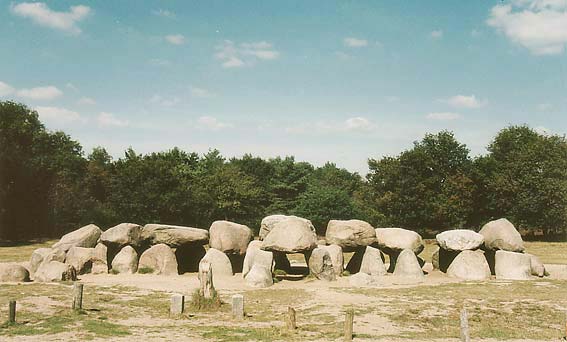

STONE AGE
BUILDING INDEX
STONE AGE
BUILDING
STANDING
STONES
NEWGRANGE
STONEHENGE
MALTA'S
MEGALITHIC
MARVELS
SKARA BRAE
HUNEBEDDEN
Hunebedden (Dutch Dolmens)
Text: H. Meijer - Dolmens in the Netherlands
The Funnel Beaker Culture
During the Neolthic period (roughly between 5300 and 2000 BCE) there lived a group of people in the North of the Netherlands known as the Funnel Beaker People, named after their claywork. During this period they build great buildings, not as great as Stonehenge or Skara Brae, but still great buildings: seemingly countless numbers of dolmens are shattered across the land. Nowadays only 54 of them survive, most of them in the province of Drenthe.
The largest of the Dutch Dolmens is "D27" in Borger. There also is the Dutch Dolmens Information Centre (Nederlands Hunebedden Informatiecentrum - NHI), worth to visit. There must have been many more dolmens in the Netherlands but our ancestors were practical people: they simply used the big stones from the dolmens to build dikes, churches and other buildings. They probably did not even realize they were desecrating graves.
Recently Dutch scolars found out that dolmens are not necessarily built by great numbers of people, they concluded this after a few of building experiments. A small group of people were capable of lifting great stones with simple levers and build a dolmen.
The pottery found in the dolmens (and gave the people their name) is covered with carvings, but no one has yet found out what it means, if it means anything at all. One scholar thinks that the carvings on the pottery have to do with the rank or position of the ones buried in that grave.

One of the many 'hunebedden' found in the north of the Netherlands
courtesy: Dolmens in the Netherlands
Mysterious Megalithes in Drenthe, Netherlands
Everyone has heard of Stonehenge in England and dolmens and menhirs in France. But who knows of even older and more numerous megalithes in Holland..? Even most of the Dutch themselves are unaware of the richness of the prehistoric monuments in their own country. But they exist..!,and they are there for over 5000 years. Older than the Egyptian pyramids! Built of huge granite stones, some of them weighing over 25,000 kilograms, dragged to the spot and piled up to form a rectangular stonegrave. Unbelievable, but true.
There are still 54 of them. 52 in the province of Drenthe and 2 in the adjacent province of Groningen. "Hunebedden" as they are called in Holland. But not built by Hunen (or huynen = giants) and not beds but graves as we know now. So Drenthe, in the northern part of the country, is the hunebedden-province. It's a province of outstanding beauty with sanddunes, woods, moors, heather, picturesque villages, 200 years old farmhouses with thatched roofs. And mysterious stonegraves..!
In Drenthe there are no mountains or rocks. But hunebedden are made of huge stones. Where did they come from..? The answer is: from Scandinavia. About 200,000 years ago, during an ice-period, Holland and most of northern Europe was covered by a thick layer of ice. The big boulders of which the hunebedden are made of have been transported to Holland by slow moving ice-glaciers. Even today, digging in Drenthe's soil, smaller and bigger stones emerge.
About 4000 BC the hunters that visited Drenthe before, changed their culture and lifestyle radically. They learned to grew wheat, to domesticate cattle and to build farmhouses. They settled here as the first farmers in the region. Archaeologists call this period the Neolithics or New Stone Age. This did not happen only here but also in the south of Sweden, in Denmark and the northwest of Germany. These farmers cut the woods with stone axes and cultivated the arable land. About 3450 BC they started building huge stonegraves using the big boulders that were scattered all over the place. They also made all sorts of earthenware, many of them in the form of a funnel. Because of that archaeologists say this people belong to The Funnel Beaker Culture.
So there is no mystery after all..? Yes there is. The big question remains unanswered. Why did these simple farmers make such a tremendous effort to drag those heavy boulders to a construction site and pile them up to making a huge stonegrave? And how on earth did they do this..? There are several theories but even today it would be a hell of a job..! A feeling of great astonishment and admiration remains.
N.B. To be exact, hunebedden in Holland are "Passage Graves" rather than dolmens, Dolmens are in fact smaller and have no passage stones for an entrance.
NEWGRANGE STONEHENGE MALTA'S MEGALITHIC MARVELS SKARA BRAE